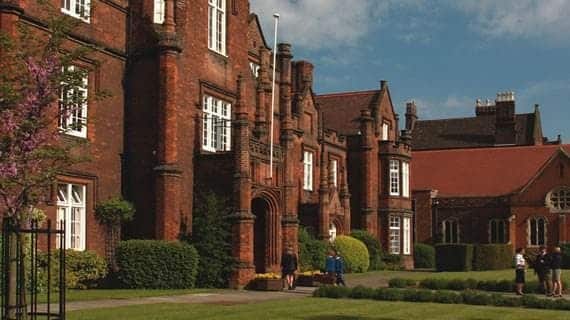There is a rich history at Ipswich School. We an ancient foundation and our thoroughly modern approach to education is set within the context of a rich historical legacy. We are proud to be continuing a six hundred year old tradition.
The first hard evidence of the school’s existence, an unpaid bill, dates from 1399 but it is likely that the school had been functioning for some years before then. Its first Charter was granted by Henry VIII and confirmed by Queen Elizabeth I. The school’s coat of arms and motto, Semper Eadem (Always the Same), are those of Elizabeth I. Her Majesty Queen Elizabeth II is the school’s Visitor. Early school buildings were located in the town centre. In 1852 the school moved into new buildings opposite Christchurch Park and has remained on this site ever since.
For much of its history Ipswich School has been closely connected with the Borough but after World War II the Governors took the decision that it should become fully independent. It has developed a strong academic reputation and is well known for its sport, cultural activities and the attention given to the care and personal development of individual pupils.
Ipswich School can claim a number of distinguished former pupils: Thomas Wolsey, Cardinal, Archbishop of York and Lord Chancellor of England under Henry VIII, almost certainly attended the school. Eminent men of action include Thomas Howard, Duke of Norfolk, the English commander at the battle of Flodden, and Rear Admiral Sir Philip Broke. He captained HMS Shannon in a celebrated engagement with the USS Chesapeake. The novelist Henry Rider Haggard was a pupil here in the 1870s and distinguished artists such as Sir Edward Poynter, President of the Royal Academy, Charles Keene of Punch, and Edward Ardizzone attended the school. In the field of science, the pioneering neuro-physiologist and Nobel Prizewinner Sir Charles Sherrington is the most distinguished Old Ipswichian to date.
Find out how we marked the hundredth anniversary of the armistice, which brought the Great War to an end and the role played by pupils of Ipswich School.
The only school mentioned by Shakespeare
Among many interesting facts about Ipswich School is that it is the only school which is mentioned in any of Shakespeare’s works. The reference is in Henry VIII, Act iv, Sc. 2, in a reference to Cardinal Wolsey. Queen Catharine (Catharine of Aragon) is in her apartments at Kenilworth with her attendant, Griffith. They are speaking of Wolsey’s death and Katharine describes what she sees as the corruption of the man responsible for her divorce from the King. Griffith, however, speaks well of Wolsey and describes his commitment to education. The ‘twins of learning’ were the school in Ipswich, the Cardinal College of St. Mary, built by Wolsey to give his old school a grand home and its sister, Cardinal College, Oxford.
Ipswich School bricks used to build Whitehall
In order to build Wolsey’s Cardinal College, the school’s home from1528-30, eight monasteries were suppressed and the Church of St. Peter appropriated to be the school chapel. The school was to be grand, built in the manner of Winchester and Eton. But since there was no stone to be had locally and the Countess of Oxford refused Wolsey permission to quarry her cliffs at Harwich, he set his sights further afield. By September 1528, ‘Mr. Daundy has sent 121 tons of Caen stone (from Normandy), and promised 1,000 more before Easter’. This was not enough and a letter from Wolsey dated 26 January 1528/9 requests the Comte de Beaumont to obtain from his master, the King of France, the grant of a special quarry at Caen, “pource que…ay commencé a bastir et ediffier deux collèges, l’un a Ypswich, qui est le lieu de ma nativite, et l’autre en l’Université de Oxenford”.
While the new buildings were not complete, the school was in residence by August 1528. Following Wolsey’s fall from the King’s grace, Henry VIII resolved that the College was to be dissolved by Michaelmas 1530 and ordered its demolition; the materials: ‘Caen stone, harde stone of Kente, Rygate stone, chimneys ready wrought,…wainscot, smith’s work, glass, the making of the kings armes, and badges in glasse, bullyons and buddes of tymbre turned carved togedre with leaves and antique works imploied to the garnysshing of the rofe of the new galerie…painting and gildyng… to be shipped to Galye Key in London’ where they were to be used to enlarge what was formerly Wolsey’s York Place and which became the royal palace of Whitehall. It did not take long to demolish the grandiose yet unfinished buildings
Visit our on line museum and archives and have a look at some of the artefacts in our school archives, photographs and copies of past school magazines.


